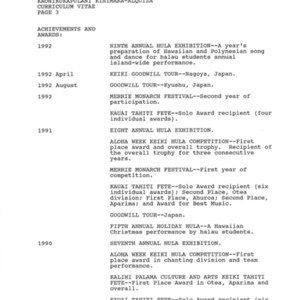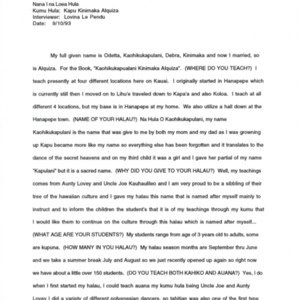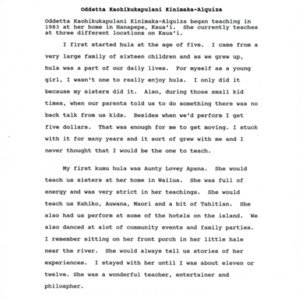Oddetta Kaohikukapulani Kinimaka-Alquiza
Title
Oddetta Kaohikukapulani Kinimaka-Alquiza
Subject
Nā Kumu Hula Oddetta Kaohikukapulani Kinimaka-Alquiza - Nānā I Nā Loea Hula Volume 2 Page 58
Description
Kapu Kinimaka-Alquiza began teaching in 1983 and is kumu hula of Nā Hula ‘O Kaohikukapulani in Kaua‘i.
I first started hula at the age of five. I came from a very large family of sixteen children and as we grew up, hula was a part of our daily lives. As a young girl I really didn’t enjoy hula. I only did it because my sisters did it. Also during those small kid times when our parents told us to do something, there was no back talk from us kids. Besides when we’d perform, I got five dollars. That was enough for me to get moving. I stuck with it for many years and it sort of grew with me. I never thought however that I would he the one to teach.
My first kumu hula was Aunty Lovey Apana. She would teach me and my sisters at her home in Wailua. She was full of energy and was very strict in her teachings. She would teach us kahiko, ‘auana, Maori, and a bit of Tahitian. I remember sitting on her front porch in her little hale near the river. She would always tell us stories of her experiences. I stayed with her until I was about eleven or twelve. She was a wonderful teacher, entertainer, and philosopher.
Out of all of my sisters I was the worst dancer. Aunty Lovey used to think that I had two left feet. I remember Aunty Lovey’s sister Shalet calling me “deaf ear and blind eye” because I had the hardest time following instructions. I’m amazed I lasted through all of that as a young girl because today I can remember many of my childhood days as a young dancer.
I then went to Uncle Joe Kahaulelio. He was a master chanter as well as an entertainer and choreographer. He taught hula ‘auana and kahiko and was very versatile in other Polynesian dances. Like Aunty Lovey, his style was very traditional: the old style with puffed ‘uwehe, very low, simple, and beautiful. However his ‘auana style was elegant, upright, and proud. I remained with Uncle Joe for many years until I got married and had my children. It was at that time I stopped to raise my family. When I was ready to start again I found out that he had moved to the mainland. I felt lost without him. Many of my hula sisters shared the same feelings.
In 1982 I was invited to participate as a dancer in the Merrie Monarch Festival with another Kaua‘i group. I would bring my two-year-old daughter to rehearsals and as she watched us from the back, she would stand up and imitate us as we were dancing. I was impressed with her comprehension, coordination, rhythm, and timing. I knew I had to find a hālau for her. So the search began. I wanted to find her a kumu hula that taught a similar style to Uncle Joe. There wasn’t anyone that I felt comfortable to send her to so my husband asked me, “What’s wrong with you? You’ve done this just about all your life; learning from great teachers of the hula. Go and seek their permission and blessings.”
So it was then that I went to express my desire to teach and hopefully to receive the blessings and permission from my kumu hula. Scared to go alone I begged my sister Kaniu to go with me. To O'ahu we went where Uncle Joe, being my last kumu, was visiting with Gramma Woodward. After dinner and a few drinks I finally had the courage to ask him. Being able to teach hula was very important to me. Hoping for him to say yes but prepared for the worst, I finally asked him. And when l asked him if it would be all right to continue his teachings in hula and the culture, he looked me straight in my eyes, put his hand on my cheek and lie said, “What took you so long? I knew you were going to be the teacher. I had tears in my eyes and happiness in my heart. He wished me well and sent me away with his blessings. I knew in my heart that whatever I do, I will do in his name as well as my first kumu hula Aunty Lovey.
I started commuting back and forth from Kaua‘i to Oʻahu to visit with Uncle Joe at his home where he would teach me chant and dance. He wasn’t well but he made time to see me. I would call him up for advice and guidance because I didn’t want to do the wrong thing or offend anyone by doing something that was not proper. Soon after on August 6, 1983 I started my first class in my garage at my home in Hanapepe with twenty students. Uncle Joe advised me to stay away from certain rituals to protect myself and my family. At that time I did not fully understand what he meant. I stressed to him that I would like to go into chants because I felt that they are the roots of our culture. He told me to take my steps very carefully and to watch what types of chants I chose. I respected his advice and moved on.
Besides Aunty Lovey and Uncle Joe, other kumu hula who have touched my life with their knowledge are kumu hula Palani Kahala who introduced me to an innovative kind of hula kahiko, and Kepa Maly and Pōhaku Nishimitsu who shared with me their traditional knowledge of hula and the Hawaiian culture. They are traditional, simple, and beautiful in their dancing and teachings. I feel most blessed to have had these great people share their lives with me. For it is their knowledge that I will keep with me and share with my students in hopes that many of them will choose to continue to pass on this wonderful tradition of the hula.
My greatest accomplishment as a teacher is being able to develop a great sense of patience in myself so I may be able to understand others in their times of difficulty. I think my dancing style comes from a variety of kumu hula but basically it reflects the styles of Aunty Lovey and Uncle Joe. We as students can learn from our kumu hula and duplicate their teaching or their style of dance. When it comes to expressing ourselves, our expression comes from within ourselves.
My hula career is dedicated to my kumu hula Uncle Joe Kahaulelio and Aunty Lovey Apana for their wonderful thoughts of wanting me to continue their teachings. They gave unselfishly of their time and love to me.
I think the hula today has changed a lot; hula has become very competitive. Some feel it’s okay and others don’t. As for me the love of hula must remain in our hearts in order for its growth to flourish.
“We as students can learn from our kumu hula and duplicate their teaching or their style of dance. When it conies to expressing ourselves, our expression conies from within ourselves."
I first started hula at the age of five. I came from a very large family of sixteen children and as we grew up, hula was a part of our daily lives. As a young girl I really didn’t enjoy hula. I only did it because my sisters did it. Also during those small kid times when our parents told us to do something, there was no back talk from us kids. Besides when we’d perform, I got five dollars. That was enough for me to get moving. I stuck with it for many years and it sort of grew with me. I never thought however that I would he the one to teach.
My first kumu hula was Aunty Lovey Apana. She would teach me and my sisters at her home in Wailua. She was full of energy and was very strict in her teachings. She would teach us kahiko, ‘auana, Maori, and a bit of Tahitian. I remember sitting on her front porch in her little hale near the river. She would always tell us stories of her experiences. I stayed with her until I was about eleven or twelve. She was a wonderful teacher, entertainer, and philosopher.
Out of all of my sisters I was the worst dancer. Aunty Lovey used to think that I had two left feet. I remember Aunty Lovey’s sister Shalet calling me “deaf ear and blind eye” because I had the hardest time following instructions. I’m amazed I lasted through all of that as a young girl because today I can remember many of my childhood days as a young dancer.
I then went to Uncle Joe Kahaulelio. He was a master chanter as well as an entertainer and choreographer. He taught hula ‘auana and kahiko and was very versatile in other Polynesian dances. Like Aunty Lovey, his style was very traditional: the old style with puffed ‘uwehe, very low, simple, and beautiful. However his ‘auana style was elegant, upright, and proud. I remained with Uncle Joe for many years until I got married and had my children. It was at that time I stopped to raise my family. When I was ready to start again I found out that he had moved to the mainland. I felt lost without him. Many of my hula sisters shared the same feelings.
In 1982 I was invited to participate as a dancer in the Merrie Monarch Festival with another Kaua‘i group. I would bring my two-year-old daughter to rehearsals and as she watched us from the back, she would stand up and imitate us as we were dancing. I was impressed with her comprehension, coordination, rhythm, and timing. I knew I had to find a hālau for her. So the search began. I wanted to find her a kumu hula that taught a similar style to Uncle Joe. There wasn’t anyone that I felt comfortable to send her to so my husband asked me, “What’s wrong with you? You’ve done this just about all your life; learning from great teachers of the hula. Go and seek their permission and blessings.”
So it was then that I went to express my desire to teach and hopefully to receive the blessings and permission from my kumu hula. Scared to go alone I begged my sister Kaniu to go with me. To O'ahu we went where Uncle Joe, being my last kumu, was visiting with Gramma Woodward. After dinner and a few drinks I finally had the courage to ask him. Being able to teach hula was very important to me. Hoping for him to say yes but prepared for the worst, I finally asked him. And when l asked him if it would be all right to continue his teachings in hula and the culture, he looked me straight in my eyes, put his hand on my cheek and lie said, “What took you so long? I knew you were going to be the teacher. I had tears in my eyes and happiness in my heart. He wished me well and sent me away with his blessings. I knew in my heart that whatever I do, I will do in his name as well as my first kumu hula Aunty Lovey.
I started commuting back and forth from Kaua‘i to Oʻahu to visit with Uncle Joe at his home where he would teach me chant and dance. He wasn’t well but he made time to see me. I would call him up for advice and guidance because I didn’t want to do the wrong thing or offend anyone by doing something that was not proper. Soon after on August 6, 1983 I started my first class in my garage at my home in Hanapepe with twenty students. Uncle Joe advised me to stay away from certain rituals to protect myself and my family. At that time I did not fully understand what he meant. I stressed to him that I would like to go into chants because I felt that they are the roots of our culture. He told me to take my steps very carefully and to watch what types of chants I chose. I respected his advice and moved on.
Besides Aunty Lovey and Uncle Joe, other kumu hula who have touched my life with their knowledge are kumu hula Palani Kahala who introduced me to an innovative kind of hula kahiko, and Kepa Maly and Pōhaku Nishimitsu who shared with me their traditional knowledge of hula and the Hawaiian culture. They are traditional, simple, and beautiful in their dancing and teachings. I feel most blessed to have had these great people share their lives with me. For it is their knowledge that I will keep with me and share with my students in hopes that many of them will choose to continue to pass on this wonderful tradition of the hula.
My greatest accomplishment as a teacher is being able to develop a great sense of patience in myself so I may be able to understand others in their times of difficulty. I think my dancing style comes from a variety of kumu hula but basically it reflects the styles of Aunty Lovey and Uncle Joe. We as students can learn from our kumu hula and duplicate their teaching or their style of dance. When it comes to expressing ourselves, our expression comes from within ourselves.
My hula career is dedicated to my kumu hula Uncle Joe Kahaulelio and Aunty Lovey Apana for their wonderful thoughts of wanting me to continue their teachings. They gave unselfishly of their time and love to me.
I think the hula today has changed a lot; hula has become very competitive. Some feel it’s okay and others don’t. As for me the love of hula must remain in our hearts in order for its growth to flourish.
“We as students can learn from our kumu hula and duplicate their teaching or their style of dance. When it conies to expressing ourselves, our expression conies from within ourselves."
Citation
“Oddetta Kaohikukapulani Kinimaka-Alquiza,” Nā Kumu Hula Archive, accessed December 13, 2025, https://nakumuhula.org/archive/items/show/127.







